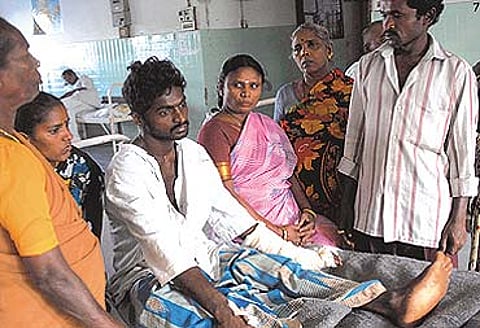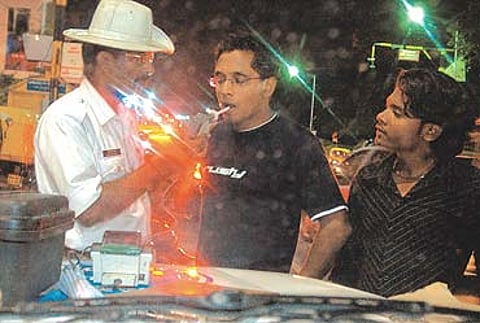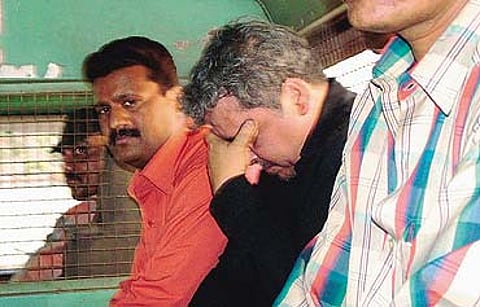On A Blur And A Wheel
Alcohol-related road accidents have become a national malaise. How did we get here and where do we head for a cure?


Darryl D’Monte, Former editor, ToI, and Bandra West Residents Association president: "These kids were at a Smirnoff party at Taj Land’s End. They were younger than the legal age for consumption of alcohol. Now, is it correct for these liquor companies to organise such events without screening these people for age eligibility, and without sending any message about drinking and driving? We try to restrain these kids, but they are so brash. There’s so much money now, parents are not bothered about theirchildren so long as they are out of sight."

Justice Leila Seth, retired chief justice, Himachal Pradesh: "It’s a reflection on what is happening in our homes, where children are not being brought up with values, but only with materialistic, irresponsible attitudes. It’s the parents who are responsible for giving their youngsters fast cars, for letting them spend their time drinking and speeding. They should guide them into other more interesting and rewarding activities like reading, playing sports, or even teaching poor children."

Alyque Padamsee, Theatre personality: "A car in the hands of a drunk driver is a lethal weapon. Parents need to take a good long, hard look at whether their kids are kind, thoughtful members of society or are wilful, spoilt brats who are only thinking of themselves and their thrills. There have always been two Indias, one the deprived and one the affluent. But today the young affluent seem not to give a damn for anybody or anything. This is a shocking reflection on the parents of today who are too busy to counsel their children."

Prof Dinesh Mohan, Road safety expert, IIT Delhi: "When our newspapers glamourise drinking on Page 3 everyday, all those pictures of people partying and holding glasses, what kind of message does that send? The truth is, millions of people drink and drive in our cities every night and get away with it. It’s not just celebrities and spoilt, rich brats. The solution doesn’t lie in making an example of them. The only thing that’ll work is random breathalyser tests at 20-30 places in the city, every single night. That’s the way other countries have managed to control drunken driving."
***
Delhi, Bangalore offer a study in contrast: in '05, Delhi registered 3,140 cases of drunken driving to 471 fatalities, Bangalore 27,673 cases to 84 road deaths.
Kerala has the highest per capita rate of alcohol consumption in the country, and the highest rate of road accidents, 15 per 1,000 vehicles
India's per capita consumption of alcohol increased a staggering 106.7 per cent over 1970-96.

Twenty-eight-year-old Sigamani Harijan's chest still bears the tyre tread scars where the car ran over him. His wife, Mariamma, fights for her life in the ICU; their one-year-old son is in the care of relatives. Fourteen-year-old Mallikarjun lost his widowed mother and eight-year-old brother. He and a younger sister, orphaned to the world, have nowhere to go, no future to look forward to.
Unknown to them, they have a phantom community out there. Around 86,000 people are killed every year in India in alcohol-related road accidents, says a study by the NGO, Community Against Drunken Driving. Of the 4 lakh-plus toll of annual road accidents, 72 per cent are due to drinking and driving. A NIMHANS study puts the figure even higher, at 80 per cent, in 2005.
These stats would mean little to Mallikarjun, or to Akanksha, 10, and Mohit, 8. Their father, Shiv Kumar Sharma, a 37-year-old constable with the Delhi Police, met his end on the capital's Ring Road earlier this year when an overspeeding truck with a drunk driver rammed into his motorcycle.

The Carter Road accident may have drawn comparisons to the infamous BMW case—Sanjeev Nanda, grandson of an ex-navy chief, is alleged to have mowed down six people, including three cops, in Delhi in '99)—but it's Mumbai with its high-profile drunk driving cases which have really 'raised the bar'! In February last, an inebriated Neel Chatterjee, 49, a V-P at Standard Chartered bank, ran over a 60-year-old watchman in his Mercedes. In '02, it was reel hero Salman Khan, running his SUV over four people sleeping outside the American Express Bakery. One of them died. In March '05, an allegedly drunk Ravindra Mhatre, personal assistant to Shiv Sena supremo Bal Thackeray, ran over two women waiting at a bus stop. In August the same year, Manish Khatau, son of industrialist Mahendra Khatau, rammed through an Independence Day nakabandi, seriously injuring Jitendra Rokade, a constable. (Manish was acquitted by a fast-track court as the prosecution could not substantiate the charges filed).
These and other "ongoing" trials, with the accused mostly out on bail or acquitted, has done little to inspire public confidence in the legal system. Little wonder, then, that the poor victims of the Carter Road incident have no real expectation of getting justice. "If Salman Khan had been punished, maybe these teenagers would have been scared...maybe this wouldn't have happened to us," says Ramesh bitterly. "The same will happen to the driver of that Toyota. He'll go free, won't he?"
There have always been two Indias: one privileged, the other deprived. But the two now seem on a collision course—and not just literally—as spoilt, inebriated youngsters who have it all too young speed their fathers' fancy cars down roads teeming with the city's poorest. "We dig all day for a hundred rupees and they blow up that money in a half-hour joyride," rues Ramesh. "They are 20, like me...."

It's a given that better salaries and easy car loans have resulted in a 'motorised generation' that has accepted drinking and driving as an urban reality. The more worrying trend is rich teens of indulgent parents doing the same much before their time. Early reports say that Alistair Pereira, 21, the man behind the wheel in the Carter Road mishap, was in possession of a fake licence—issued long before he was of legal age.
The ugly side of this reality is all the young lives snuffed out even before they reach the permissible drinking age of 25. A WHO report says that 50 per cent of road accident victims worldwide are in the 15-44 age group. The picture is equally grim here. Though countrywide data is difficult to come by, city-specific statistics concur with the WHO report. For example, in Bangalore, people in the 20-40 age group account for 60 per cent of road fatalities.
In Delhi, Mumbai and Bangalore, drunk driving figures have been showing steady increase, year on year. Kerala has the twin distinction of having the highest annual per capita consumption of liquor—8.3 litres—and the highest rate of road accidents—15 per 1,000 vehicles—in the country. Road safety experts believe there is a strong connection between the two figures.
Not surprisingly, data from the Indian Alcohol Policy Association shows figures sympathetic to those above. Per capita consumption of alcohol has increased by a staggering 106.7 per cent over a 25-year period from 1970 to 1996. Alcohol sales have been growing at a rate of 6 per cent per year, and this is expected to jump to 8 per cent. Factors like relaxed licensing rules and surrogate advertising by liquor companies may also be contributing to the growing alcoholism and consequent drunken driving.

To get a reality check on the issue, Outlook visited an upmarket nightclub in South Delhi. Being a Saturday night it was packed, with most customers in the 20-30 age group. Potent cocktails and beer were being tossed down like there was no tomorrow. Chatting with a bunch of corporate executives in their mid-20s, we found they had all travelled in one car. Weren't they scared of getting caught, perhaps getting involved in an accident? "I have never been caught and there aren't many cops around anyway that late in the night," said one confidently. "We've drunk much more at times, and managed to reach home...," said another, his words slurring.
Their confidence is not misplaced. Delhi police rarely bothers drunk drivers. Twenty-seven-year-old Kalyan Banerjee, a dentist, talks about his lone brush with the cops. "I was going back home, drunk of course, when some cops intercepted me. They asked for my papers...said there was nothing to worry, I just had to pay the fine." A relieved Kalyan willingly paid the Rs 2,000 fine, adding a "tip" of Rs 500.

Taking the D&D scene into another realm are also the thrill-seekers. Like Paniker Shah, a small businessman in Mumbai. "When you are 4-5 drinks down and driving, you see the road but you don't understand it.... You see the speedometer and think, 'Hey, I can go faster than this.' You don't care for life at that moment," he says.
Now, does Shah even know that drinking and driving is a punishable offence under Section 185 of the Motor Vehicles Act, 1988. Any driver found with blood alcohol levels higher than the legally permitted 30 mg/100 ml can get six months in jail. Conversely, at the authority's discretion, he can also be let off with a fine of Rs 2,000 or less (which, one suspects, would mean little to the average partygoer).
Punishment is much more harsh in many other parts of the world though. In London, for instance, a person convicted of drunk driving can lose his/her job. The law also disqualifies a driver for a 12-month minimum if found guilty of drinking and driving. This practice is followed in most of the developed world. In the US, interest rates on life and vehicle insurance go up for five years if you have been booked for drinking and driving.
As everyone knows, things are a lot better for the glassy-eyed here. For starters, a licence is as easy to procure as a 6 pm hangover. Even metros like Mumbai don't have a computerised licence database. "City police departments even now don't have any records of regular offenders," says Maxwell Pereira, ex-JCP Traffic, Delhi.

Professor Dinesh Mohan, a road safety expert at iit Delhi, believes that stringent police checks are the most effective way to curb drunk drivers and accident fatalities. It's worked wonders for Bangalore. Random checking means the number of cases filed here is much higher than in Mumbai and Delhi. But the corresponding number of fatalities is also much lower than in Delhi. In 2005, there were 27,673 registered cases of drunken driving and 84 road fatalities due to it in Bangalore. In Delhi, only 3,140 cases were filed, but 471 people died due to drunk driving.
Says M.A. Saleem, Deputy Commissioner of Police, Traffic East, Bangalore: "We have been consistent in these exercises for the last 2-3 years, resulting in a marked decline in road fatalities due to drunken driving. From 108 casualties in 2004, we came down to 84 in 2005...and there have been only 16 deaths so far this year." At the other end is neighbouring Kerala, with both the highest road accident rate and the highest liquor consumption in the country.
Incidentally, a simple rule among partygoers can bring down accident rates to almost nil: when going to a party or out to drink, one member abstains and takes the responsibility of dropping everyone else home.
A rule that Amar Dudeja, 23, should have kept in mind as he zipped down Delhi's streets at 3 am on a cold winter night last February. Dead drunk and without a seatbelt, Amar was heading home at over 100 kmph after a rocking party at Hotel Ashok when he lost control. He spent three days in hospital, escaping with just a few stitches and a badly battered car. There are thousands who never survive to tell the tale. But he did. He recalls that a cult song by Aussie heavy-metal band AC/DC was blaring on his stereo as he lost control—a song that almost became his epitaph: No stop signs, speed limit/Nobody's gonna slow me down.../I'm going down, all the way down/I'm on the highway to hell.
Tags